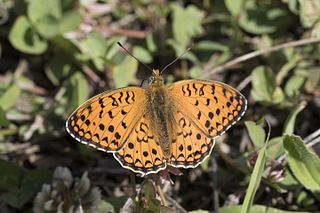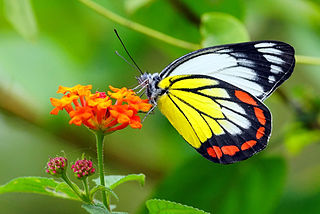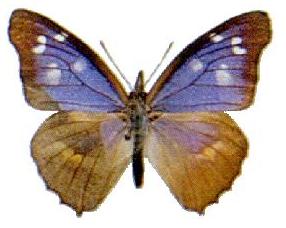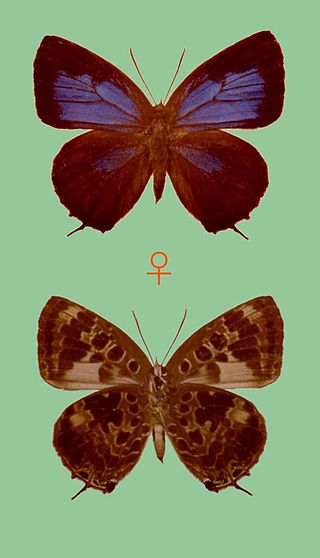
The green hairstreak is a small butterfly in the family Lycaenidae.

The Niobe fritillary is a species of butterfly in the family Nymphalidae.

Delias hyparete, the painted Jezebel, is a medium-sized butterfly of the family Pieridae, found in South Asia and Southeast Asia.

Libythea geoffroy, the purple beak, is a butterfly found in parts of India and Myanmar that belongs to the subfamily Libytheinae of the family Nymphalidae.

Delias is a genus of butterflies. There are about 250 species of the genus Delias, found in South Asia and Australia. The genus is considered to have its evolutionary origins in the Australian region.

Ornithoptera paradisea, the paradise birdwing, is a species of birdwing butterfly found in New Guinea.

Erebia is a Holarctic genus of brush-footed butterflies, family Nymphalidae. Most of the about 90–100 species are dark brown or black in color, with reddish-brown to orange or more rarely yellowish wing blotches or bands. These usually bear black spots within, which sometimes have white center spots.

Parnassius nomion, the Nomion Apollo, is a forest steppe butterfly which is found in the Urals, Altai, south Siberia, Amur and the Ussuri region, Mongolia, China and Korea. It is a member of the snow Apollo genus (Parnassius) of the swallowtail family (Papilionidae).

Morpho rhetenor, the Rhetenor blue morpho, is a Neotropical butterfly of the family Nymphalidae. It is found in Suriname, French Guiana, Brazil, Peru, Ecuador, Colombia, and Venezuela.

Polyommatus amandus, the Amanda's blue, is a butterfly of the family Lycaenidae. It is found in the Palearctic realm.

Chazara briseis, the hermit, is a butterfly species belonging to the family Nymphalidae. It can be found in North Africa, southern Europe, Asia Minor, the Caucasus, Kazakhstan, Central Asia through Afghanistan, and north-western China and Tuva. It is found on steppe and in other dry grassy places between 500 and 2,500 meters.

Polyommatus (Plebicula) dorylas, the turquoise blue, is a butterfly of the family Lycaenidae. It is found in southern Europe, Asia Minor, the Ural Mountains, Caucasus and Transcaucasia. Its wingspan is 15–17 mm. The butterfly's common name comes from the dazzling bright blue colour of male's wings. The larvae feed on Anthyllis vulneraria. The butterfly flies from May to September in two generations. Habitats include flowery meadows in rocky areas at 500–2000 m.

Bematistes pseudeuryta is a butterfly in the family Nymphalidae. It is found in Angola, the Democratic Republic of the Congo, Sudan and western Uganda.
Emil Weiske was a German naturalist.

Delias ninus, the Malayan Jezebel, is a butterfly in the family Pieridae. It was described by Alfred Russel Wallace in 1867. It is found in the Indomalayan realm.

Arhopala staudingeri is a species of butterfly in the family Lycaenidae. It was described by Georg Semper in 1890. It is found in the Indomalayan realm, where it is endemic to the Philippines.















